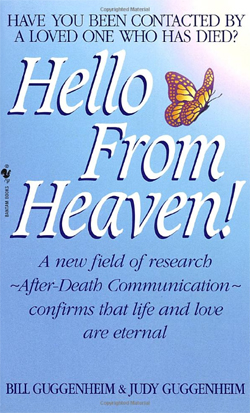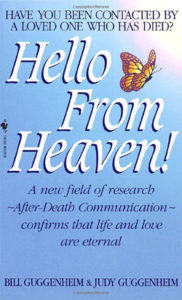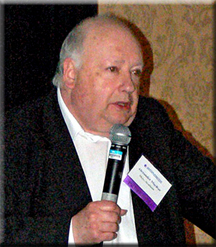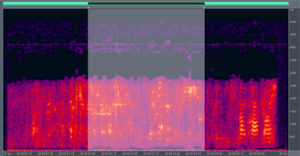by Douglas M. Stokes
(Previously published in the Society for Psychical Research April 2009 Paranormal Review)
In these pages (Stokes, 2004) and elsewhere, I have argued for the existence of multiple selves (conceived as spheres of pure consciousness) within each human being. Such a modular view of the human mind is frequently adopted by modern neuroscientists to address such phenomena such as behavioral conflict between the hemispheres of split-brain patients and “blindsight,” in which a cortically blind patient evidences knowledge of visual targets that she does not consciously perceive.
Descartes’ Error
When Descartes famously said, “I think, therefore I am,” I do not believe his error lies in the second clause (the affirmation of the existence of a continuing and unified self), as such writers as Dennett (1991) and Churchland (2002) would have us believe. The experience of oneself as a continuing field of consciousness is for me immediately given. If I cannot even know that I am a field of consciousness that continues from moment to moment, then I cannot know anything. To second Descartes’ conclusion, the knowledge of oneself’s existence, at least from moment to moment, cannot be doubted.
For me, Descartes’ error lies not in his conclusion, but rather in his premise. As a continuing field of consciousness, I do not think; rather, my hapless brain does the bulk of my thinking for me. As has been made abundantly clear by modern research in cognitive neuroscience, my thoughts, my feelings, and the other elements that make up my personality are dependent on brain activity, and if that activity is radically altered or discontinued, they will not persist in any recognizable manner. However, my true self, construed as a field of pure consciousness, might persist, either trapped in a vegetative brain or on to new adventures.
To me the evidence of a continuing self is not that it thinks, which it cannot do without massive assistance from a brain, but that it has feelings and experiences (termed “quales” by the philosophers). Thus, a rectified version of Descartes’ statement might be: “I’m nauseous, therefore I am.”
Mini-Shins
I have termed the multiple spheres of consciousness within each person “mini-Shins,” which is an adaptation of the term “Shin,” coined by Thouless and Wiesner (1948) to refer to the conscious self in a way that avoids the theoretical and religious baggage that accompanies the use of the word “soul.”
Each such self, if receiving input from widespread areas of the brain, might fall under the delusion that it is the sole center of consciousness in the person.
The informational span of even the executive sphere of consciousness may be quite unimpressive. The psychologist George Miller famously proclaimed that the human mind was able to hold only 7 + 2 items in consciousness at one time (and I question the plus sign for me and my fellow sexagenarians). Whatever else you might say about fields of consciousness, they generally seem to be stunningly stupid all by themselves.
For instance, due to attentional blindness, subjects even fail to notice a gorilla walking among a group of players passing a basketball back and forth (Simons & Chabris, 1999). Thus, mini-Shins may not have a very impressive informational-processing capacity (unlike the brain).
The Evolution of Consciousness
Advocates of the anthropic principle maintain that the laws of physics and the initial conditions of the universe appear to be delicately designed to allow the evolution of conscious observers. The prominent physicist and mathematician John Wheeler (1983) suggested that under quantum theory, the universe could not exist unless it contained a conscious observer to collapse its state vector and thus grant reality to it. Similarly, Walker (2000) argued for the existence of disembodied “proto-consciousnesses” scattered throughout the universe, whose job it is to surf the vast void, to render reality from the vast fog of uncollapsed possibilities.
However, the universe itself appears relatively indifferent to at least human consciousness, which has only existed for a measly half a million years, compared to the 13.7 billion years of the universe’s existence (which itself is an amazingly short time when one stops to consider that the Earth itself is 4.6-billion-year-old).
The vast reaches of space appear to be filled primarily with eerily beautiful lifeless voids sprinkled here and there with dust, clouds, and seemingly uninhabited, lifeless rocks. Given our perhaps carbon-based prejudices, most of the universe appears to be indifferent to, if not outright hostile to, the presence of conscious observers. If, as the advocates of the anthropic principle maintain, the laws of the universe appear to be designed to support conscious observers, it does not seem to be a very “cost-effective” design (the recent discoveries of a large number of extrasolar planets not withstanding). Thus, some (e.g., Hill, 2005) have argued that if the universe is designed to produce any observers at all, it appears that most such observers would be inhabitants of lifeless rocks and clouds of plasma, rather than snuggled warmly in the neocortex of a primate brain. As noted above, Walker (2000) suggested that the universe is suffused with proto-consciousnesses, which though observation cause quantum potentiality to become reality, even in regions remote from carbon-based life-forms. If so, these proto-consciousnesses or mini-Shins can apparently be imprisoned in brains, at least for brief periods of time. However, if they are like most other things in the universe, from antiprotons to Z particles, it is likely that they are capable of being reshuffled and recycled from physical system to physical system, in a process that might be described as a form of memory-less and more or less continual reincarnation.
One answer to the proponents of the anthropic principle is that there may be multiple “bubble universes” evidencing different sets of physical laws and initial conditions. Alternatively, the universe may undergo cycles of Big Bangs followed by Big Crunches. In each cycle the universe may emerge phoenix-like from its ashes, perhaps with its laws and initial conditions reinitialized. Penrose (2008) has proposed that, in fact, the universe may have undergone an infinity of such cycles in the past. In either case, the reason why we find ourselves in a universe that supports the existence of conscious thinkers (vs. conscious observers) is that there would be no complex thoughts if the universe were a lifeless void. To paraphrase Descartes once again, “I think, therefore I must somehow be glued to a complex brain.” At least for the moment.
The Hierarchy of Consciousness
This view leads naturally to panpsychism, the view that consciousness pervades the universe. Many of the most prominent practitioners of human thought, including Leibniz, Spinoza, and Alfred North Whitehead have proposed that consciousness pervades all things and that, at root, the universe consists of a plenitude of spheres of pure consciousness, or “monads” in Leibniz’ terminology. In the early stages of my intellectual career, I scoffed at the notion that a rock might be consciousness. How silly my naive rejection appears in retrospect. It is a shame that the cosmos of Leibniz, Spinoza, and Whitehead has to be “discovered” anew by each generation, due to the fact this point of view is drowned in a seemingly ubiquitous sea of irrationalism on the part of all sides in the debate over religion.
One advantage of this view is that it does not need to explain how consciousness arose from insentient matter, which is perhaps the most vexing, fundamental and seemingly unsolvable problem confronting modern science and philosophy. Consciousness was here from the start. It is angels all the way down.
Our bodies are composed of a vast number of cells and bacteria, with only a fraction of them from our own species. In fact, our bodies seem more akin to a ferocious battleground for microorganisms, which are replaced from minute to minute, than to a unified entity. If one is to grant consciousness to animals “all the way down,” could not our white blood cells possess a (possibly dim) conscious capable of recognizing their foes and engulfing them? Might plants be conscious? While they seem less complex than us, rice plants contain upwards of 50,000 genes, compared to a measly 20,000 to 25,000 for a human being. Thus, appearances may be deceiving. Is it inconceivable that plants possess a glimmer of consciousness, perhaps operating on a much slower time frame than we do? If one watches plants in a speeded up movie, their behavior seems almost animal-like as they open and close their petals and stretch to capture the maximum sunlight. Do plants experience thirst when deprived of water (to say nothing of the Venus flytrap, which might be expected to experience pleasure as it emits a contented burp)? It is true that plants have no nervous systems; however, might we not be biased toward neurons because of our present unfortunate location? McGinn (1999) for instance begins his book The Mysterious Flame with a short story in which future silicon-based artificial intelligences stumble across the Earth and are astounded to find lumps of meat that can think (our brains).
Our brains are essentially comprised of colonies of single-celled animals (our neurons). What if these animals could move? Might their collective then be considered an even more complex brain?
Hölldobler and Wilson (2008) propose that communities of insects comprise “superorganisms” and that evolutionary selection acts on the colony as a unit, rather than on the on the individual insects. Can the whole of humanity be considered as a single super-brain? If so, are there (perhaps somewhat oxymoronic) mega-mini-Shins associated with the global sphere of consciousness? Goldberg (2009) has even suggested that in the future the Internet may develop into an “advanced intrinsic consciousness” (p. 54).
And what of the famous thermostat? Can it be said to be aware of the rise of heat? Might rocks as they weather and absorb radiation experience consciousness on an extremely slow time span? As I work in my current job I sometime catch glimpses of the patterns on my Windows media player that resemble the light show at the end of Kubrick’s 2001: A Space Odyssey. I sometimes think that the consciousness of a rock might be something like that (as well as how much more peaceful it would be to be such a rock rather than to return to the Microsoft Word window at which I am toiling).
In view of the complexity of the quantum mechanical wave governing the behavior of individual physical particles, it might not be too big of a stretch to hypothesize that a single proton might possess consciousness. Edwards (2006) has argued that single neurons may be centers of consciousness, again based on complexity of input. Each of these centers of consciousness would fall under the illusion that it is the sole center of consciousness in the body.
Attributing consciousness to elementary particles would seem to ignore the usual roles attributed to consciousness by cognitive neuroscientists, which include attention and the binding of diverse neural activity into the unified perception of an object (as well as other functions, such as learning novel tasks and decision-making). In his recent review of studies relating to attention, Yantis (2008) notes that process of directing attention remains unexplained by current findings in neuroscience. Munz (2008) notes that the “binding problem” also remains unexplained, and he even attributes such “binding” to an entity outside of the brain, namely human culture.
It does seem as though the center of consciousness that is the “master of the brain” is somehow able to direct such behavior as the writing of this article. However, perhaps that center is just “lucky” enough to be in the right place and the right time to direct the writing of this article. (It might, for instance, be conceived as affixed to Broca’s area in the left hemisphere, as it does seem to choose the words I will use. Other mini-Shins might for instance have the jobs of moving one’s limbs. Sometimes when I think about it, I am amazed that that my arm actually obeys my directions and executes an intricate sequence of movements without any “micro-management” on my part.)
The Universe and All That
The physicist James Jeans (1937) famously noted that the universe resembles “a great thought” more than it does a “great machine,” given that quantum mechanics has undermined the mechanistic worldview of classical physics, which is grounded in the now discredited doctrine of local realism. Indeed, some have asked, if the universe is a great thought, why does it go through the trouble of actually existing? As Leibniz asked, why is there something rather than nothing? Also, if the universe is a thought, why does the thought appear to be of the consequences of an elaborate set of mathematical laws? As Jeans noted, God appears to be a pure mathematician. Similarly, the Nobel laureate physicist Eugene Wigner asked, what explains the “unreasonable effectiveness” of mathematics in describing the physical universe? Goldberg (2009) compares the universe to a great equation. He views the universe as self-created, as mathematical truths are fundamental and exist outside of space and time. [1]
However, if the universe is a great thought, why is it not more dream-like, with Alice and Wonderland capriciousness? The vastness and law-like nature of the universe explains why the idealist philosophical viewpoint that the world is mental in nature has lost ground to the view that the material world is the only reality, which ultimately led to the view that mind itself is impotent and has little or no standing in the physical universe.
However, even the very dust from which we were born and into which we will die may well still carry still the stuff of mind.
References
Churchland, P. S. (2002). Brain-wise: Studies in neurophilosophy. Cambridge, MA: MIT Press.
Dennett, D. C. (1991). Consciousness explained. Boston: Little, Brown.
Edwards, J. C. W. (2006). How many people are in my head? And in hers? Exeter, UK: Imprint Academic.
Goldberg, S. (2009). Anatomy of the soul: Mind, God and the afterlife. Miami, FL: Medmaster, Inc.
Hill, T. (2005). [Letter to the Editor.] Skeptical Inquirer, 29(1), 61.
Hölldobler, B. & Wilson, E. O. (2008). The superorganism: The beauty, elegance and strangeness of insect societies. New York: Norton.
Jeans, J. (1937). The mysterious universe. Cambridge, England: Cambridge University Press.
McGinn, C. (1999). The mysterious flame. New York: Basic Books.
Munz, P. (2008). Why homo sapiens had to be saved by culture. Journal of Consciousness Studies, 15(12),57-73.
Penrose, R. (2008). Causality, quantum theory and cosmology. In Connes, A., Heller, M., Majid, S., Penrose, R., Polkinghorne, J. & Taylor, A., On space and time (pp.141-195). Cambridge, UK: Cambridge University Press.
Simons, D. J. & Chabris, C. F. (1999). Gorillas in our midst: Sustained inattentional blindness for dynamic events. Perception, 28, 1059-1074.
Stokes, D. M. (2004). The survival problem: Up close and personal. Paranormal Review, 3 (April 2004), 3-9
Thouless, R. H., & Wiesner, B. P. (1948). The psi process in normal and “paranormal” psychology. Journal of Parapsychology, 12, 192–212.
Walker, E. H. (2000). The physics of consciousness. Cambridge, MA: Perseus Books.
Wheeler, J. A. (1983). Law without law. In J. A. Wheeler & W. H. Zurek (Eds.), Quantum theory and measurement (pp. 182-213). Princeton, NJ: Princeton University Press.
Yantis, S. (2008). The neural basis of selective attention” Cortical sources and targets of attentional modulation. Current Directions in Psychological Science, 17, 86-90.
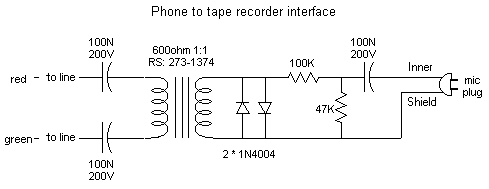 The above device permits the connection of a household phone (and phone line) to a tape recorder or computer soundcard for EVP voice recording purposes.
The above device permits the connection of a household phone (and phone line) to a tape recorder or computer soundcard for EVP voice recording purposes. A couple of stand-alone telephones can be energized locally to form a simulated network (see above diagram) for experimentation. The output shown, connects to the phone interface.
A couple of stand-alone telephones can be energized locally to form a simulated network (see above diagram) for experimentation. The output shown, connects to the phone interface.

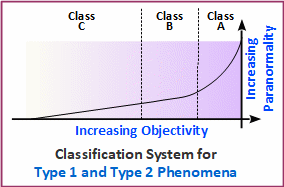 A distinction is made between phenomena which are always present and phenomena which are transient features. A face seen in the decomposition pattern of a leaf is more or less always there, as opposed to a face found in moving water or video-loop noise. As a general rule, “always there” phenomena appear to be formed by opportunistically adapting naturally occurring processes to express the message, assuming one is intended. If perceived as phenomena, “always there” features would be considered Type 2.
A distinction is made between phenomena which are always present and phenomena which are transient features. A face seen in the decomposition pattern of a leaf is more or less always there, as opposed to a face found in moving water or video-loop noise. As a general rule, “always there” phenomena appear to be formed by opportunistically adapting naturally occurring processes to express the message, assuming one is intended. If perceived as phenomena, “always there” features would be considered Type 2.
 As Margaret Downey explains her experimental set-up, “I have a Canon PowerShot A75 Digital camera. It allows me to do thirty seconds of video at a time. I leave it on the highest resolution (640 x 480 pixels). For effects, I use the function button to set the camera to shoot in sepia (a brownish tone), tungsten (which makes it blue), and black and white. I also do a session using just normal settings.
As Margaret Downey explains her experimental set-up, “I have a Canon PowerShot A75 Digital camera. It allows me to do thirty seconds of video at a time. I leave it on the highest resolution (640 x 480 pixels). For effects, I use the function button to set the camera to shoot in sepia (a brownish tone), tungsten (which makes it blue), and black and white. I also do a session using just normal settings.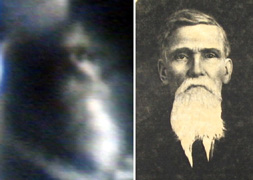 “Once in awhile, I’ll place a crystal or a crystal ball in the water. And sometimes I ask my hubby to shine red and blue lights in the water.
“Once in awhile, I’ll place a crystal or a crystal ball in the water. And sometimes I ask my hubby to shine red and blue lights in the water. In one experiment, Margaret asked for her grandparents and received this ITC picture of a bearded man she feels is her Great Great Grandfather, Benjamin Franklin Main Sr. He was a physician and Baptist minister who crossed in 1913. Today, he and his grandson, Lewis (Margaret’s grandfather who crossed in 1993), help her in making connections to other people.
In one experiment, Margaret asked for her grandparents and received this ITC picture of a bearded man she feels is her Great Great Grandfather, Benjamin Franklin Main Sr. He was a physician and Baptist minister who crossed in 1913. Today, he and his grandson, Lewis (Margaret’s grandfather who crossed in 1993), help her in making connections to other people.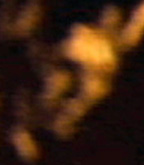 Margaret also has captured a picture of a face that she feels is her Indian guide, Walking Sun, who she had asked to come through during an experiment. Margaret had a reading from a Shaman who told her, “Margaret’s heart hears the drum beat of Mother Earth and her spirit finds the stairway to Father Sky.” She told Margaret that if she asked for her guide, Walking Sun, he would come. Margaret says, “One of the Shaman’s comments in my reading was that people with “dove medicine” can see between the worlds and the veil between earth and the spirit world is thin for them. She talked about being clairaudient and hearing spirit/sensing vibrations. It was so fun to be able to tell her after the reading about EVP/ITC!”
Margaret also has captured a picture of a face that she feels is her Indian guide, Walking Sun, who she had asked to come through during an experiment. Margaret had a reading from a Shaman who told her, “Margaret’s heart hears the drum beat of Mother Earth and her spirit finds the stairway to Father Sky.” She told Margaret that if she asked for her guide, Walking Sun, he would come. Margaret says, “One of the Shaman’s comments in my reading was that people with “dove medicine” can see between the worlds and the veil between earth and the spirit world is thin for them. She talked about being clairaudient and hearing spirit/sensing vibrations. It was so fun to be able to tell her after the reading about EVP/ITC!”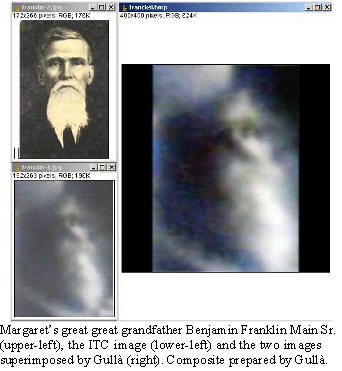 In the last NewsJournal, we reported about how Margaret Downey conducts visual ITC experiments using moving water for optical energy. The article can be read in the
In the last NewsJournal, we reported about how Margaret Downey conducts visual ITC experiments using moving water for optical energy. The article can be read in the 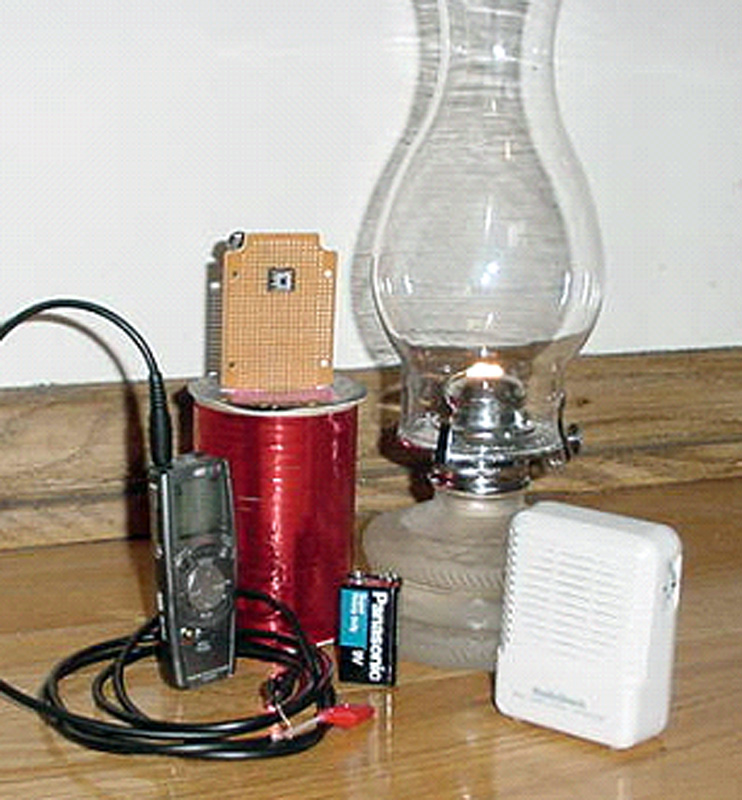



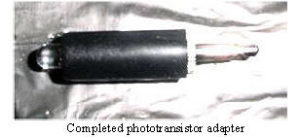 This article presents an experimental approach for making EVP recordings. Its purpose is instructional and to help promote an understanding of vibrational energy and how we may better perceive it.
This article presents an experimental approach for making EVP recordings. Its purpose is instructional and to help promote an understanding of vibrational energy and how we may better perceive it. The technique involves use of a single, widely available electronic component called a phototransistor. This is not the same as a diode which was used by early EVP researchers. The phototransistor I recommend is available at any Radio Shack store or available from them online. The part number is 276-145. My tests have shown that the device is responsive to infrared, visible and ultraviolet light. All of these frequencies of light mentioned are well above radio broadcast, cell and microwave transmission frequencies.
The technique involves use of a single, widely available electronic component called a phototransistor. This is not the same as a diode which was used by early EVP researchers. The phototransistor I recommend is available at any Radio Shack store or available from them online. The part number is 276-145. My tests have shown that the device is responsive to infrared, visible and ultraviolet light. All of these frequencies of light mentioned are well above radio broadcast, cell and microwave transmission frequencies.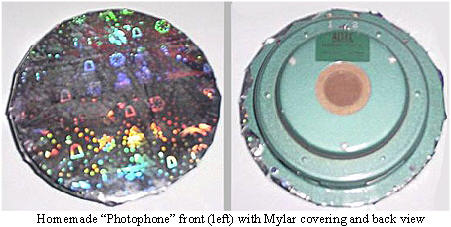 Solder the phototransistor to the phone plug as follows: The phototransistor has a flat edge on its case, this is the collector mark. The remaining lead is called the emitter; Connect (solder) the collector to the short pin of the phone plug; and, the emitter connects to the long pin of the phone plug. The photo shows the completed assembly ready for use.
Solder the phototransistor to the phone plug as follows: The phototransistor has a flat edge on its case, this is the collector mark. The remaining lead is called the emitter; Connect (solder) the collector to the short pin of the phone plug; and, the emitter connects to the long pin of the phone plug. The photo shows the completed assembly ready for use. For example, a quartz-tube space heater at full power (glowing) will produce a very pure thermal white noise. Place the recorder in your car and drive around. You may be surprised at what you can hear in the filtered sunshine as the levels of light change as you drive. If you have a crystal or mineral collection you may try recording reflections or direct light shined through a crystal (sunshine, LED flashlight or a laser pointer works well).
For example, a quartz-tube space heater at full power (glowing) will produce a very pure thermal white noise. Place the recorder in your car and drive around. You may be surprised at what you can hear in the filtered sunshine as the levels of light change as you drive. If you have a crystal or mineral collection you may try recording reflections or direct light shined through a crystal (sunshine, LED flashlight or a laser pointer works well). Hold the completed Photophone so sunlight reflected from the surface of the shiny, flexible mirror shines on the phototransistor. Now speak closely and loudly to the surface of the Photophone. On playback you should hear your own voice. The quality will depend on how well your voice vibrates the surface of the Photophone. For more controlled experiments, you can connect the loudspeaker to a stereo or amplifier and play different sounds through it to vibrate the film. Just place the speaker so that sunlight reflects from the surface to the phototransistor. Try using music, Spiricom tones, babble or even white noise, as an example.
Hold the completed Photophone so sunlight reflected from the surface of the shiny, flexible mirror shines on the phototransistor. Now speak closely and loudly to the surface of the Photophone. On playback you should hear your own voice. The quality will depend on how well your voice vibrates the surface of the Photophone. For more controlled experiments, you can connect the loudspeaker to a stereo or amplifier and play different sounds through it to vibrate the film. Just place the speaker so that sunlight reflects from the surface to the phototransistor. Try using music, Spiricom tones, babble or even white noise, as an example. You may wish to build a phototransistor cable that can be used with your home computer sound card for recording. The Radio Shack part number of the cable to use is 42-2434. The six-foot cable has a molded 1/8” plug on one end and tinned leads on the other end, ready to connect the phototransistor. The connections are as follows: inner conductor of cable connects to phototransistor collector (flat edge), outer (shield) connects to emitter.
You may wish to build a phototransistor cable that can be used with your home computer sound card for recording. The Radio Shack part number of the cable to use is 42-2434. The six-foot cable has a molded 1/8” plug on one end and tinned leads on the other end, ready to connect the phototransistor. The connections are as follows: inner conductor of cable connects to phototransistor collector (flat edge), outer (shield) connects to emitter.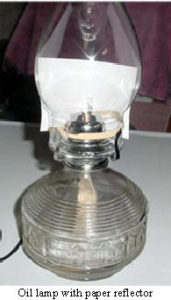 these lamps is cotton and works well. I have begun tests with other wick materials as of this writing. I attach the phototransistor and cable assembly to the lamp with a thick rubber band. A reflector is required to be placed behind the phototransistor. A white 3 x 5-file card is excellent for this purpose. This simple reflector greatly increases the gain of the microphone. If your sound card allows audio monitoring, you can experiment with the flame level for best reproduction of your voice. A high flame level can overload the phototransistor. Start with a low flame and ratchet it up slowly. Speak into the chimney of the lamp or across its top if you are sensitive to the exhaust fumes. Use an ultra-pure liquid paraffin lamp fuel for lowest odor.
these lamps is cotton and works well. I have begun tests with other wick materials as of this writing. I attach the phototransistor and cable assembly to the lamp with a thick rubber band. A reflector is required to be placed behind the phototransistor. A white 3 x 5-file card is excellent for this purpose. This simple reflector greatly increases the gain of the microphone. If your sound card allows audio monitoring, you can experiment with the flame level for best reproduction of your voice. A high flame level can overload the phototransistor. Start with a low flame and ratchet it up slowly. Speak into the chimney of the lamp or across its top if you are sensitive to the exhaust fumes. Use an ultra-pure liquid paraffin lamp fuel for lowest odor.